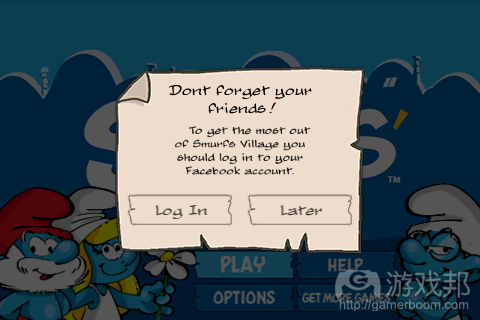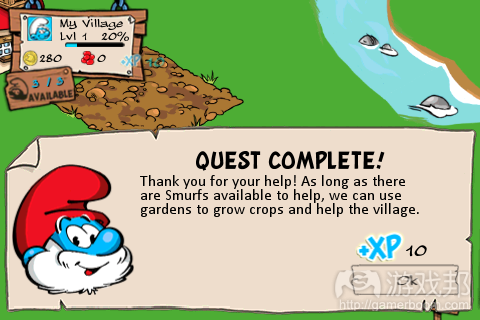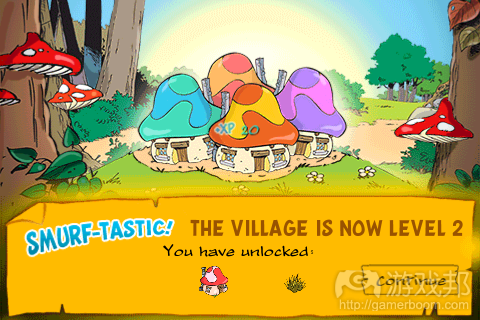如何制作一款令人上瘾的社交游戏?
和AAA游戏开发者不同,网络社交游戏设计师早就意识到可用性和用户体验对其成功的重要性。用户能够轻松免费访问社交游戏内容,无需预先付费,这对在头几分钟吸引和留住玩家来说至关重要。
今天我们就来谈谈成功社交游戏的头5分钟,重点讲述其中关键要素。从中我们能够学习如何制作富有沉浸性的社交游戏。
游戏内容
首先看看《Farmville》,因为《Farmville》是社交游戏的成功代表。游戏促使我登陆Facebook帐号,只有登陆我才能够体验游戏(假设我对这款游戏没有任何兴趣,也丝毫不影响其成为成功典范)。
我从“综合热门iPhone应用榜单”中发现了《Smurf’s Village》。和《Farmville》一样,这是款地理地貌游戏,玩家需给蓝精灵创建新村庄,照顾它们的农作物。更重要的是,游戏采用免费模式,但仍然是整合实力突出的作品,显然游戏将继续其成功之路。那么《Smurf’s Village》的头5分钟内容是什么呢?
游戏体验
体验这款游戏遇到的首个内容是询问我是否要将游戏连接至Facebook页面。这是应用开发商的首个商业目标,因为这会增加游戏曝光度,这是社交游戏运作方式的关键要素。但对用户体验来说更重要的是玩家能够自由选择(游戏邦注:这和《Farmville》不同)。我当时拒绝了该项连接:
在简短说明蓝精灵为何移动后,游戏直接进入村庄建造内容。游戏提供详细指导,告诉我点击图标,铺平土地:
之后我便立刻获得积极回应“任务完成”,然后就是巩固学到内容:
接着在“种植蓝莓”环节又重复同样步骤,箭头清楚告知我需要完成的内容。任务完成后我便获得积极反馈:
此后我晋升至新等级:
游戏继续前进,下个等级告诉玩家如何建造房屋,以及如何通过蓝精灵果子加速游戏进程。由于蓝精灵果子是游戏付费商品,因此是开发商的主要创收渠道,是个需尽早植入的链接:
这促使我晋升至另一等级。游戏接着继续教我如何种植草坪,然后让我体验一款迷你游戏避免体验变得枯燥。若我几分钟后接着体验,游戏就会“给我自由空间”,让我利用学到经验自由建造村庄。
游戏法则
那么游戏前5分钟取得成功的关键法则是什么?
1. 逐一解释任务,帮助玩家动手完成
* 游戏坚持每次解释一项任务,首先先说明任务内容,然后指导他们动手完成,确保玩家获悉如何操作。游戏随后确认活动是否正确,告知玩家完成情况。
* 重复任务数次,帮助玩家获悉如何操作。
2. 奖励正确完成任务玩家
* 任务完成后,游戏将会给出系列成功表示。不仅通过画面 告知任务已完成,还会奖励玩家经验积分以及弹出“任务完成”对话框,此外游戏还会升级玩家村庄。
* 奖励正确完成任务玩家将促使其继续游戏(游戏邦注:就像《幻幻球》的《欢乐颂》配乐)。
3. 向玩家展示目标空间
* 将游戏设置成原始村庄遭受破坏场景,让玩家重新建造村庄,这主要给继续游戏的玩家提供新内容。
* 这点或许能够通过引入社交元素进行强化,因为玩家能从中看到其他玩家的完整村庄。
4. 让玩家把握控制权
* 经过指导阶段(坦白讲,超过5分钟)后,游戏主导权应转移至玩家手中,告知他们游戏潜在发展空间,让他们自主选择,设计建造方案。
* 虽然游戏不断有新目标涌现,但完成这些目标的方式更加自由(游戏邦注:相比指导阶段而言),玩家能够在游戏玩法中融入自己的创造性。
以上这些元素都促使社交游戏持续成功的重要因素。(本文为游戏邦/gamerboom.com编译,如需转载请联系:游戏邦)
How to make an addictive social game
by Steve
Unlike some ‘triple A’ game developers, web-based social game designers quickly recognised how important usability and user experience are to their success. With customers being able to easily access their content for free, without making a commitment to paying for their gaming experience up-front, it’s extremely important to attract and retain players in the first few minutes.
Today I’ll be looking at the first 5 minutes of a successful social game, and highlighting which elements have made this game successful. In the future we’ll look at some games which have missed the point, and hence lost a large proportion of their customer base. From this, we can learn how to make an addictive social game.
The Game
The game we were originally going to study was intended to be Farmville, since Farmville is famously the ‘poster-child’ of social gaming success. However it wanted me to connect with my facebook account, and wouldn’t let me play without doing so. Game over! (Presumably this is just an annoyance to me however, and hasn’t stopped the game’s success)
Instead, I looked at the ‘Top Grossing’ iPhone apps, and found ‘Smurf’s Village’. Like farmville, it’s a landforming game, where the player has to create a new village for the Smurfs, and look after their crops. Most importantly, it’s free, yet still a top-grossing app – clearly a sign of it’s continued success. (or was it all the work of this kid charging $1400 to their parents credit card) So, what happens in the first 5 minutes of Smurf’s Village?
The Experience
The first thing that happens when running the game is that it asks if I want to hook it up to facebook. This is a key business goal for the app developer, since it increases awareness of the game and is a key element to how social games work. Importantly for the user experience however, it is optional (unlike Farmville). I declined at this time:
After a very short introductory story, explaining why the Smurfs are moving, the game drops you straight into making a new village. With clear directions, the game tells me to click on the sign and lay a plot of land:
And with that, I get an immediate positive reaction “Quest complete”, and reinforcement of the lesson I just learnt:
Now the same happens again with ‘growing blueberrys’, where an arrow clearly indicates what I need to do, and I’m given positive reinforcement having completed this task:
And with that, a level up is gained:
The game goes on, with the next level teaching you how to build a house, and crucially linking speeded up progress with using smurfberrys. Since smurfberries are the games in-app-purchase, and hence the primary method the developer makes money, this is an important link to make early on:
This earns me another level up. The game then goes on to repeat this to teach me how to build grass, before letting me play a mini-game to break up the monotony. If I were to continue playing beyond the first few minutes, the game would go on to ‘set me free’ and let me use the lesson’s I’ve learnt to continue to build the village unguided.
The Rules
So, what magic rules did we find that led to a successful first 5 minutes with this game?
1. Explain actions one at a time, let the player do them
* The game takes care to only show the player one action at a time, and first describes the task, before guiding them through performing the task themselves, to ensure that players know how to do it. The game then confirms the correct action has taken place after it has been completed, and tells the player what they did.
* By repeating the action numerous times, the game hence reinforces to the player how the action is achieved.
2. Reward the player for performing an action correctly
* When an action has been performed, there are multiple layers of success shown. Not only are there visible indications that the task has taken place, and the player is rewarded with both experience points and a ‘quest complete’ dialog, but the game also levels up the player’s village.
* Hence there is positive reinforcement that the correct action has taken place, causing the player to want to perform it again, much like Peggle’s Ode to Joy
3. Show the player the potential of what they can achieve
* By setting the game after the destruction of the original village, and allowing them to build a new one from the ground-up, this game highlights what can be done by the player if they were to continue playing.
* This message would potentially be reinforced by introducing the social element of the game, for it will be possible to see other player’s complete villages.
4. Let them take control
* After the tutorial period (admittedly longer than the 5 minutes I played for today), the game will hand over the reins to the player, having shown them what’s possible, and give the ability to create solutions in a manner of their own choosing.
* Although there will be continued goals to achieve, the method to achieve these goals becomes more free-form after the tutorial allowing the player to introduce creativity into their gameplay.
All these factors have been an important part of the continued success of this social game. Soon I will look at an alternative, unsuccessful, social game, and note what factors lead to its failure.(Source:stevebromley)













































 闽公网安备35020302001549号
闽公网安备35020302001549号